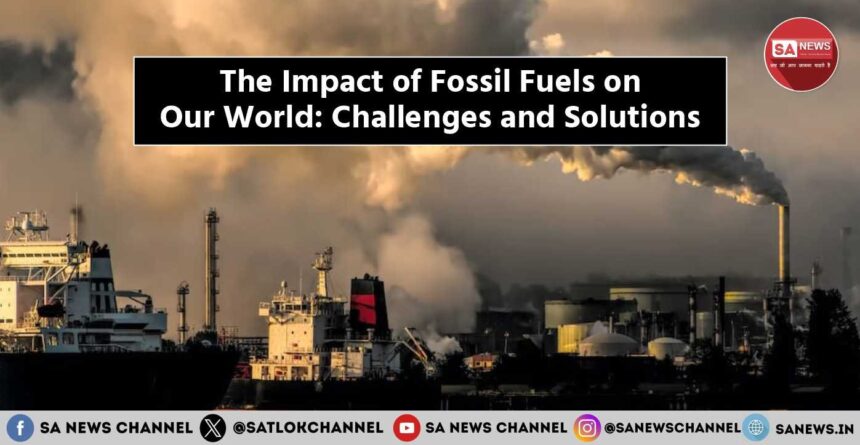Fossil fuels, which include coal, oil, and natural gas, have a fascinating and complex origin story. These energy sources are formed from the remains of ancient plants and animals that lived millions of years ago. The process begins with the accumulation of organic material in prehistoric swamps, oceans, and forests. Over the course of time, these materials became encased beneath successive layers of sediment. As the layers built up, the increased pressure and heat caused the organic material to undergo chemical and physical changes, transforming it into the fossil fuels we use today.
The formation of coal, for instance, began in ancient swamps where plant material accumulated. Over millions of years, this material was buried and subjected to intense pressure and heat, eventually becoming coal. Oil and natural gas, on the other hand, originated from marine organisms. When these organisms died, they sank to the ocean floor, where they were buried under sediment. The combination of heat and pressure converted the organic matter into hydrocarbons, which we subsequently extract in the form of oil and natural gas.
Importance of fossil fuels
Fossil fuels have been the cornerstone of modern industrial civilization. Their high energy density makes them an incredibly efficient source of energy for a wide range of applications. From generating electricity to powering vehicles and industrial machinery, fossil fuels have enabled rapid technological advancements and economic growth.
Coal was the first fossil fuel to be widely used during the Industrial Revolution, providing the energy needed to power steam engines and factories. The advent of the internal combustion engine and the development of oil drilling techniques in the late 19th and early 20th centuries further expanded the use of fossil fuels. Oil and natural gas have become vital resources for transportation, heating, and the generation of electricity.
Today, fossil fuels account for a significant portion of the world’s energy consumption. They are crucial for the functioning of modern economies, supporting industries, transportation networks, and residential energy needs. Despite the rise of renewable energy sources, fossil fuels remain indispensable due to their reliability and scalability.
Environmental Effects of fossil fuels
The environmental consequences of fossil fuels are significant and complex.The extraction, transportation, and combustion of fossil fuels release a wide range of pollutants into the environment, contributing to air and water pollution, habitat destruction, and climate change.
The combustion of fossil fuels is the primary source of carbon dioxide (CO2) emissions, which are a major driver of global warming. CO2 is a greenhouse gas that traps heat in the Earth’s atmosphere, leading to rising temperatures, melting ice caps, and more frequent extreme weather events. The burning of coal, oil, and natural gas also releases other pollutants, such as sulfur dioxide (SO2), nitrogen oxides (NOx), and particulate matter, which can cause respiratory and cardiovascular diseases in humans.
■ Also Read: Sustainable Technology Trends: Innovations and Solutions
Oil spills and leaks from pipelines and tankers can have devastating effects on marine and coastal ecosystems. The Deepwater Horizon oil spill in 2010, for example, released millions of barrels of oil into the Gulf of Mexico, causing widespread environmental damage and economic losses.
The extraction of fossil fuels can also lead to habitat destruction and biodiversity loss. Coal mining, particularly mountaintop removal mining, can permanently alter landscapes and disrupt ecosystems. Fracking, a method used to extract natural gas, has been linked to groundwater contamination and increased seismic activity.
Inflation Effects on fossil fuels
Fossil fuel prices are notoriously volatile, and fluctuations in these prices can have significant effects on global economies. When fossil fuel prices rise, the cost of goods and services that depend on these fuels also increases, leading to inflation. Conversely, when prices drop, it can lead to economic instability in regions that rely heavily on fossil fuel revenue.
The impact of fossil fuel price volatility is particularly pronounced in developing countries, where energy costs make up a larger share of household and business expenses. Rising fuel prices can lead to higher transportation and production costs, which are often passed on to consumers in the form of higher prices for goods and services. This can reduce purchasing power and slow economic growth.
In developed countries, fossil fuel price fluctuations can also affect inflation rates and economic stability. For example, the oil crises of the 1970s led to severe economic recessions in many Western countries, highlighting the vulnerability of economies to fossil fuel price shocks.
History of using fossil fuels
The history of fossil fuels is deeply intertwined with the history of human civilization. The use of coal dates back thousands of years, with evidence of its use in ancient China and by the Romans. However, it was during the Industrial Revolution in the 18th and 19th centuries that fossil fuels began to play a central role in powering human progress.
The invention of the steam engine by James Watt in the late 18th century revolutionized transportation and manufacturing, driving demand for coal. The identification of oil in Pennsylvania in 1859 signified the inception of the contemporary oil industry. The development of the internal combustion engine and the rise of the automobile industry in the early 20th century further fueled the demand for oil.
Natural gas, initially considered a byproduct of oil extraction, began to gain importance in the mid-20th century as a cleaner alternative to coal and oil for electricity generation and heating. Advances in drilling technology, including hydraulic fracturing (fracking), have significantly increased the availability of natural gas in recent decades.
The widespread use of fossil fuels has transformed societies, enabling unprecedented economic growth and technological advancements. However, it has also led to significant environmental and health challenges, prompting a growing awareness of the need for sustainable energy solutions.
Efforts to Combat Fossilflation
To combat the economic instability caused by fluctuating fossil fuel prices, many countries are investing in renewable energy sources like solar and wind power. These sources provide more stable pricing and reduce dependency on fossil fuels.
Governments and organizations are also promoting energy efficiency measures to reduce overall energy consumption and mitigate the impact of fossil fuel price volatility. By improving energy efficiency in buildings, transportation, and industrial processes, countries can reduce their reliance on fossil fuels and enhance energy security.
Additionally, the development of advanced energy storage technologies, such as batteries, can help stabilize energy prices by allowing renewable energy to be stored and used when needed. This can reduce the reliance on fossil fuels during periods of high demand or low renewable energy production.
International cooperation is also crucial in addressing fossilflation. Countries can work together to stabilize fossil fuel markets, invest in renewable energy infrastructure, and share best practices for energy efficiency and sustainability.
Inflation Reduction Act
The Inflation Reduction Act aims to address the economic impacts of fossil fuel price volatility by promoting energy efficiency, supporting the development of renewable energy infrastructure, and providing incentives for the adoption of clean energy technologies.
The Act includes provisions for investment in renewable energy projects, such as solar and wind farms, as well as tax credits and subsidies for individuals and businesses that adopt energy-efficient technologies. By reducing dependence on fossil fuels and promoting clean energy, the Act seeks to create a more stable and resilient energy market.
In addition to promoting renewable energy, the Inflation Reduction Act also includes measures to improve energy efficiency in buildings and transportation. This includes incentives for retrofitting existing buildings with energy-efficient technologies, such as insulation, heating and cooling systems, and lighting.
The Act also encourages the development of electric vehicles (EVs) and the expansion of EV charging infrastructure. By reducing reliance on gasoline and diesel, the widespread adoption of EVs can help stabilize fuel prices and reduce the economic impact of fossil fuel price fluctuations.
Illness and Deaths due to use of Fossil Fuels
The combustion of fossil fuels produces pollutants such as particulate matter, sulfur dioxide, and nitrogen oxides, which can lead to respiratory and cardiovascular diseases. Long-term exposure to these pollutants is linked to illnesses and premature deaths, particularly in urban areas with high fossil fuel usage.
According to the World Health Organization (WHO), air pollution from fossil fuel combustion is a major environmental health risk, contributing to millions of premature deaths each year. Particulate matter, in particular, can penetrate deep into the lungs and bloodstream, causing inflammation and exacerbating conditions such as asthma, bronchitis, and heart disease.
In addition to respiratory and cardiovascular diseases, exposure to fossil fuel pollutants has been linked to other health issues, including cancer, neurological disorders, and adverse pregnancy outcomes. Children, the elderly, and individuals with preexisting health conditions are particularly vulnerable to the health impacts of fossil fuel pollution.
Efforts to reduce fossil fuel consumption and transition to cleaner energy sources are essential for improving public health and reducing the burden of pollution-related diseases.
Phase-Out of fossil fuels
Many countries are now setting ambitious goals to phase out the use of fossil fuels. This involves transitioning to renewable energy sources, improving energy efficiency, and adopting cleaner technologies. The phase-out is crucial for mitigating climate change and reducing environmental damage.
The phase-out of fossil fuels requires a multifaceted approach, including policy measures, technological advancements, and behavioral changes. Governments can implement policies such as carbon pricing, renewable energy mandates, and fossil fuel subsidies removal to incentivize the shift to cleaner energy sources.
Investments in research and development are also critical for advancing renewable energy technologies and making them more affordable and efficient. Innovations in energy storage, grid infrastructure, and electric transportation can support the transition to a low-carbon economy.
Public awareness and engagement are essential for driving the phase-out of fossil fuels. Educating individuals and communities about the benefits of renewable energy and the importance of reducing fossil fuel consumption can help build support for sustainable energy policies and practices.
Just Transition from fossil fuels
A just transition ensures that the shift from fossil fuels to renewable energy is fair and equitable. This includes providing support for workers in fossil fuel industries, investing in education and training for new green jobs, and ensuring that vulnerable communities are not disproportionately affected by the transition.
Workers in fossil fuel industries may face job losses and economic uncertainty as the world transitions to cleaner energy sources. A just transition involves providing retraining and reskilling opportunities to help these workers find new employment in the renewable energy sector or other industries.
Investing in education and workforce development is essential for preparing individuals for the green jobs of the future. This includes developing training programs in renewable energy technologies, energy efficiency, and sustainable practices. Ensuring that vulnerable communities are included in the transition to renewable energy is crucial. These communities often bear the brunt of environmental pollution and may lack the resources to adapt to new technologies. Policies that support affordable clean energy access, community-based renewable energy projects, and environmental justice initiatives can help create a more equitable transition.
Divestment
Divestment involves withdrawing investments from companies involved in fossil fuel extraction and production. Many institutions, including universities, pension funds, and religious organizations, are divesting from fossil fuels to promote sustainability and reduce their environmental impact.
The divestment movement aims to shift capital away from fossil fuels and towards renewable energy sources and sustainable businesses. By divesting from fossil fuels, investors can signal their commitment to addressing climate change and supporting a low-carbon economy. This movement also seeks to raise awareness about the environmental and social impacts of fossil fuel investments and encourage broader systemic change.
Industrial Sector
The industrial sector is one of the largest consumers of fossil fuels, using them for energy, raw materials, and transportation. Transitioning this sector to renewable energy sources and improving energy efficiency is critical for reducing global fossil fuel consumption.
Industries can adopt a range of strategies to reduce their reliance on fossil fuels, including:
- Energy Efficiency: The adoption of energy-efficient technologies and practices has the potential to greatly decrease both energy usage and expenses.
- Renewable Energy: Investing in renewable energy sources, such as solar, wind, and biomass, can help industries reduce their carbon footprint.
- Circular Economy: Adopting circular economy principles, such as recycling and reusing materials, can reduce the demand for fossil fuel-derived products.
- Electrification: Electrifying industrial processes and transportation can reduce reliance on fossil fuels and facilitate the integration of renewable energy.
Collaboration between governments, industry leaders, and stakeholders is essential for driving the transition to a sustainable industrial sector.
Subsidies
Governments around the world provide substantial subsidies to fossil fuel industries, supporting exploration, production, and consumption. These subsidies can distort energy markets, making fossil fuels artificially cheap and undermining efforts to promote renewable energy.
Reducing or eliminating fossil fuel subsidies can help level the playing field for renewable energy sources and encourage a shift toward cleaner alternatives. Redirecting subsidies to support renewable energy projects, energy efficiency initiatives, and sustainable infrastructure can accelerate the transition to a low-carbon economy.
Lobbying Activities
Fossil fuel companies engage in extensive lobbying activities to influence energy policies and regulations. These activities can hinder progress toward reducing fossil fuel dependence and transitioning to renewable energy. Increased transparency and regulation of lobbying activities are essential for ensuring that energy policies align with environmental and public health goals.
Efforts to curb the influence of fossil fuel lobbying include:
- Campaign Finance Reform: Implementing measures to limit corporate contributions to political campaigns.
- Transparency: Requiring disclosure of lobbying activities and expenditures by fossil fuel companies.
- Public Engagement: Encouraging public participation in energy policy decision-making processes.
- Accountability: Holding policymakers accountable for decisions that favor fossil fuel interests over environmental and public health.
The Path to a Sustainable Future
The transition away from fossil fuels is not just a technological challenge but a societal one. It requires a collective effort from governments, businesses, communities, and individuals to rethink our energy systems and adopt sustainable practices. Here are some key steps to achieving a sustainable future:
- Investing in Renewable Energy: Governments and private sectors need to invest heavily in renewable energy infrastructure, such as wind, solar, and hydroelectric power. This includes funding for research and development to improve the efficiency and affordability of these technologies.
- Promoting Energy Efficiency: Energy efficiency measures can significantly reduce energy consumption and greenhouse gas emissions. This includes retrofitting buildings with energy-efficient technologies, promoting energy-efficient appliances, and encouraging energy-saving behaviors.
- Supporting Technological Innovation: Technological advancements, such as energy storage, smart grids, and electric vehicles, are essential for a sustainable energy transition. Governments can provide incentives for innovation and support the commercialization of new technologies.
- Implementing Carbon Pricing: Carbon pricing mechanisms, such as carbon taxes and cap-and-trade systems, can provide economic incentives for reducing greenhouse gas emissions. By putting a price on carbon, these mechanisms encourage businesses and individuals to adopt cleaner energy practices.
- Encouraging Behavioral Changes: Public awareness campaigns and education can promote sustainable behaviors, such as reducing energy consumption, using public transportation, and supporting renewable energy. Changing consumer habits and lifestyles is crucial for reducing the demand for fossil fuels.
- Ensuring Energy Justice: A just transition to renewable energy must address social equity and ensure that the benefits of clean energy are accessible to all. This includes providing support for marginalized communities, creating green jobs, and ensuring affordable access to clean energy.
- Strengthening International Cooperation: Climate change is a global challenge that requires international collaboration. Countries need to work together to share knowledge, resources, and technologies to accelerate the transition to a sustainable energy future.
The Role of Individuals
While systemic change is necessary, individuals also play a crucial role in the transition to a sustainable future. Here are some ways individuals can contribute:
- Reducing Energy Consumption: Simple actions, such as turning off lights, using energy-efficient appliances, and reducing water heating, can lower energy consumption and reduce carbon footprints.
- Supporting Renewable Energy: Individuals can choose to purchase renewable energy from their utility providers or install solar panels on their homes. Supporting renewable energy projects and advocating for clean energy policies can also make a difference.
- Adopting Sustainable Transportation: Using public transportation, biking, walking, or driving electric vehicles can reduce reliance on fossil fuels and lower greenhouse gas emissions.
- Practicing Sustainable Living: Reducing waste, recycling, and choosing sustainable products can help lower environmental impact. Supporting local and sustainable businesses can also promote a greener economy.
- Educating and Advocating: Staying informed about environmental issues and advocating for sustainable policies can drive collective action. Educating others about the importance of sustainability can also inspire positive change.
Conclusion
The journey to a sustainable future is complex and multifaceted, but it is achievable through collective effort and commitment. By transitioning away from fossil fuels and embracing renewable energy, promoting energy efficiency, supporting technological innovation, and ensuring a just transition, we can create a more sustainable and equitable world. Every individual, community, and nation has a role to play in this critical endeavor, and together, we can build a brighter future for generations to come.
Transitioning to Authenticity: with Sant Rampal Ji Maharaj
Just as the shift from fossil fuels to renewable energy represents a commitment to a sustainable future, the movement towards authentic spiritual practices signifies a return to the foundational truths that can lead to personal and collective salvation. In the realm of spirituality, there has been a growing recognition that many traditional practices may not align with the true essence of spiritual worship.
This realization has led to a quest for authenticity and deeper understanding among spiritual seekers. Among the contemporary spiritual leaders advocating for this return to genuine practices, Sant Rampal Ji emerges as a significant figure. His teachings emphasize the importance of authentic spiritual worship and virtuous living, paralleling the global movement towards sustainable practices that prioritize the well-being of humanity and the planet.
Sant Rampal Ji articulates that true salvation and spiritual fulfillment are attainable through the acquisition of genuine spiritual knowledge, which is often obscured by misinterpretations and superficial practices. He underscores the importance of the guidance of a SatGuru, a true spiritual teacher, who can illuminate the path toward enlightenment.
Central to His teachings are the recitation of specific mantras known as Satnaam and Saarnaam. These mantras are believed to purify the soul, alleviating it of karmic burdens and facilitating a deeper connection with the divine.
By following a path rooted in truth, devotion, and ethical living, individuals are encouraged to transcend the limitations of their current existence and strive for liberation. This journey leads to the attainment of Satlok, the eternal realm of peace and fulfillment. Sant Rampal Ji’s teachings resonate with the principles found in various holy scriptures, drawing connections between different faiths and guiding devotees toward a unified understanding of spiritual enlightenment.






![Understanding Biological Classification A Comprehensive Guide to Organizing Life [2025]](https://santrampalji-files.sgp1.digitaloceanspaces.com/sanews.in/2024/12/30154608/Understanding-Biological-Classification-A-Comprehensive-Guide-to-Organizing-Life-2025-330x220.jpg)


